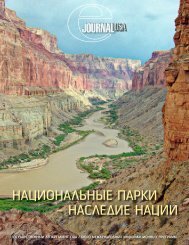AMERICAN
Outline of American Literature
Outline of American Literature
- No tags were found...
Create successful ePaper yourself
Turn your PDF publications into a flip-book with our unique Google optimized e-Paper software.
failing marriage.<br />
In Glück’s memorable The Wild<br />
Iris (1992), different kinds of flowers<br />
utter short metaphysical monologues.<br />
The book’s title poem, an<br />
exploration of resurrection, could<br />
be an epigraph for Glück’s work as<br />
a whole. The wild iris, a gorgeous<br />
deep blue flower growing from a<br />
bulb that lies dormant all winter,<br />
says: “It is terrible to survive / as<br />
consciousness / buried in the dark<br />
earth.” Like Jorie Graham’s vision<br />
of the self merged in the snowstorm,<br />
Glück’s poem ends with a<br />
vision of world and self merged —<br />
this time in the water of life, blue<br />
on blue:<br />
You who do not remember<br />
passage from the other world<br />
I tell you I could speak again:<br />
whatever<br />
returns from oblivion returns<br />
to find a voice;<br />
from the center of my life came<br />
a great fountain, deep blue<br />
shadows on azure seawater.<br />
Like Graham, Glück merges the<br />
self into the world through a fluid<br />
imagery of water. While Graham’s<br />
frozen water — snow — resembles<br />
sand, the earth ground up at<br />
the sea’s edge, Glück’s blue fresh<br />
water — signifying her heart —<br />
merges with the salt sea of the<br />
world.<br />
CHARLES WRIGHT<br />
Photo © Nancy Crampton<br />
125<br />
THE POETRY OF PLACE<br />
number of poets — these are<br />
not groups, but nationwide<br />
tendencies — find deep<br />
inspiration in specific landscapes.<br />
Instances are Robert Hass’s lyrical<br />
evocations of Northern California,<br />
Mark Jarman’s Southern California<br />
coastlines and memories of surfing,<br />
Tess Gallagher’s poems set in<br />
the Pacific Northwest, and Simon<br />
Ortiz’s and Jimmy Santiago Baca’s<br />
poems emanating from southwestern<br />
landscapes. Each subregion<br />
has inspired poetry: C.D. (Carolyn)<br />
Wright’s hardscrabble upper South<br />
is far from Yusef Komunyakaa’s<br />
humid Louisiana Gulf.<br />
Poetry of place is not based on<br />
landscape description; rather, the<br />
land, and its history, is a generative<br />
force implicated in the way its people,<br />
including the poet, live and<br />
think. The land is felt as what D.H.<br />
Lawrence called a “spirit of place.”<br />
A<br />
Charles Wright (1935- )<br />
One of the most moving poets of<br />
place is Charles Wright. Raised in<br />
Tennessee, Wright is a cosmopolitan<br />
southerner. He draws on Italian<br />
and ancient Chinese poetry, and<br />
infuses his work with southern<br />
themes such as the burden of a<br />
tragic past, seen in his poetic<br />
series “Appalachian Book of the<br />
Dead,” which is based on the<br />
ancient Egyptian Book of the Dead.<br />
His works include Country Music:<br />
Selected Early Poems (l982);<br />
Chickamauga (1995); and Negative<br />
Blue: Selected Later Poems (2000).<br />
Wright’s intense poetry offers
















